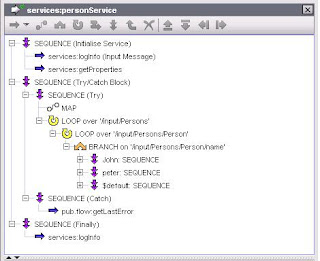This Blog will explain the basic structure of a webmethods flow service. It has initialise sequence followed by a try/Catch and finally block.Lets have a look at the properties at each stages of the sequence.
Open Webmethods Developer and create a flow service called personService as shown in the following diagram. Please make sure that the document types are already created for your input and output docs.

If you want to try out some more features like branches,loops etc, you can design your flow service like the following diagram.

Set the ExitOn property for Try/Catch Sequence based on the following diagram.

Similarly set the Exit on prperty for Catch sequence to DONE and default(Failure) for Finally sequence. Run/Step through the Service with appropirate input Payload and check the results
Hope you find this article useful
Regards,
Amol



